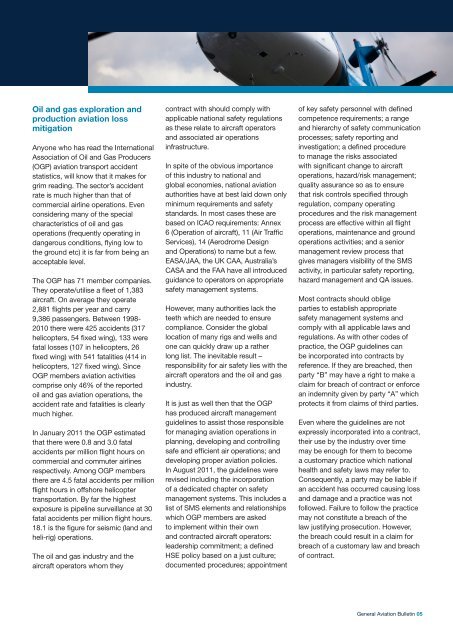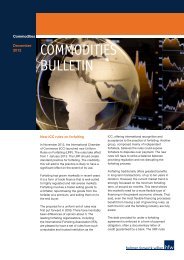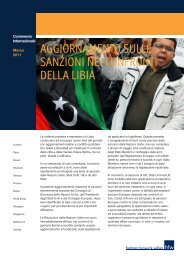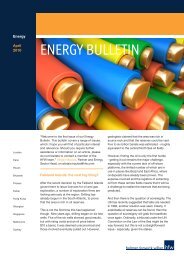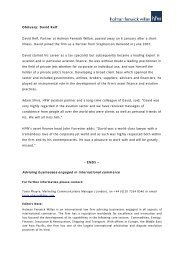GLOBAL GA - Holman Fenwick Willan
GLOBAL GA - Holman Fenwick Willan
GLOBAL GA - Holman Fenwick Willan
You also want an ePaper? Increase the reach of your titles
YUMPU automatically turns print PDFs into web optimized ePapers that Google loves.
Oil and gas exploration and<br />
production aviation loss<br />
mitigation<br />
Anyone who has read the International<br />
Association of Oil and Gas Producers<br />
(OGP) aviation transport accident<br />
statistics, will know that it makes for<br />
grim reading. The sector’s accident<br />
rate is much higher than that of<br />
commercial airline operations. Even<br />
considering many of the special<br />
characteristics of oil and gas<br />
operations (frequently operating in<br />
dangerous conditions, flying low to<br />
the ground etc) it is far from being an<br />
acceptable level.<br />
The OGP has 71 member companies.<br />
They operate/utilise a fleet of 1,383<br />
aircraft. On average they operate<br />
2,881 flights per year and carry<br />
9,386 passengers. Between 1998-<br />
2010 there were 425 accidents (317<br />
helicopters, 54 fixed wing), 133 were<br />
fatal losses (107 in helicopters, 26<br />
fixed wing) with 541 fatalities (414 in<br />
helicopters, 127 fixed wing). Since<br />
OGP members aviation activities<br />
comprise only 46% of the reported<br />
oil and gas aviation operations, the<br />
accident rate and fatalities is clearly<br />
much higher.<br />
In January 2011 the OGP estimated<br />
that there were 0.8 and 3.0 fatal<br />
accidents per million flight hours on<br />
commercial and commuter airlines<br />
respectively. Among OGP members<br />
there are 4.5 fatal accidents per million<br />
flight hours in offshore helicopter<br />
transportation. By far the highest<br />
exposure is pipeline surveillance at 30<br />
fatal accidents per million flight hours.<br />
18.1 is the figure for seismic (land and<br />
heli-rig) operations.<br />
The oil and gas industry and the<br />
aircraft operators whom they<br />
contract with should comply with<br />
applicable national safety regulations<br />
as these relate to aircraft operators<br />
and associated air operations<br />
infrastructure.<br />
In spite of the obvious importance<br />
of this industry to national and<br />
global economies, national aviation<br />
authorities have at best laid down only<br />
minimum requirements and safety<br />
standards. In most cases these are<br />
based on ICAO requirements: Annex<br />
6 (Operation of aircraft), 11 (Air Traffic<br />
Services), 14 (Aerodrome Design<br />
and Operations) to name but a few.<br />
EASA/JAA, the UK CAA, Australia’s<br />
CASA and the FAA have all introduced<br />
guidance to operators on appropriate<br />
safety management systems.<br />
However, many authorities lack the<br />
teeth which are needed to ensure<br />
compliance. Consider the global<br />
location of many rigs and wells and<br />
one can quickly draw up a rather<br />
long list. The inevitable result –<br />
responsibility for air safety lies with the<br />
aircraft operators and the oil and gas<br />
industry.<br />
It is just as well then that the OGP<br />
has produced aircraft management<br />
guidelines to assist those responsible<br />
for managing aviation operations in<br />
planning, developing and controlling<br />
safe and efficient air operations; and<br />
developing proper aviation policies.<br />
In August 2011, the guidelines were<br />
revised including the incorporation<br />
of a dedicated chapter on safety<br />
management systems. This includes a<br />
list of SMS elements and relationships<br />
which OGP members are asked<br />
to implement within their own<br />
and contracted aircraft operators:<br />
leadership commitment; a defined<br />
HSE policy based on a just culture;<br />
documented procedures; appointment<br />
of key safety personnel with defined<br />
competence requirements; a range<br />
and hierarchy of safety communication<br />
processes; safety reporting and<br />
investigation; a defined procedure<br />
to manage the risks associated<br />
with significant change to aircraft<br />
operations, hazard/risk management;<br />
quality assurance so as to ensure<br />
that risk controls specified through<br />
regulation, company operating<br />
procedures and the risk management<br />
process are effective within all flight<br />
operations, maintenance and ground<br />
operations activities; and a senior<br />
management review process that<br />
gives managers visibility of the SMS<br />
activity, in particular safety reporting,<br />
hazard management and QA issues.<br />
Most contracts should oblige<br />
parties to establish appropriate<br />
safety management systems and<br />
comply with all applicable laws and<br />
regulations. As with other codes of<br />
practice, the OGP guidelines can<br />
be incorporated into contracts by<br />
reference. If they are breached, then<br />
party “B” may have a right to make a<br />
claim for breach of contract or enforce<br />
an indemnity given by party “A” which<br />
protects it from claims of third parties.<br />
Even where the guidelines are not<br />
expressly incorporated into a contract,<br />
their use by the industry over time<br />
may be enough for them to become<br />
a customary practice which national<br />
health and safety laws may refer to.<br />
Consequently, a party may be liable if<br />
an accident has occurred causing loss<br />
and damage and a practice was not<br />
followed. Failure to follow the practice<br />
may not constitute a breach of the<br />
law justifying prosecution. However,<br />
the breach could result in a claim for<br />
breach of a customary law and breach<br />
of contract.<br />
General Aviation Bulletin 05


